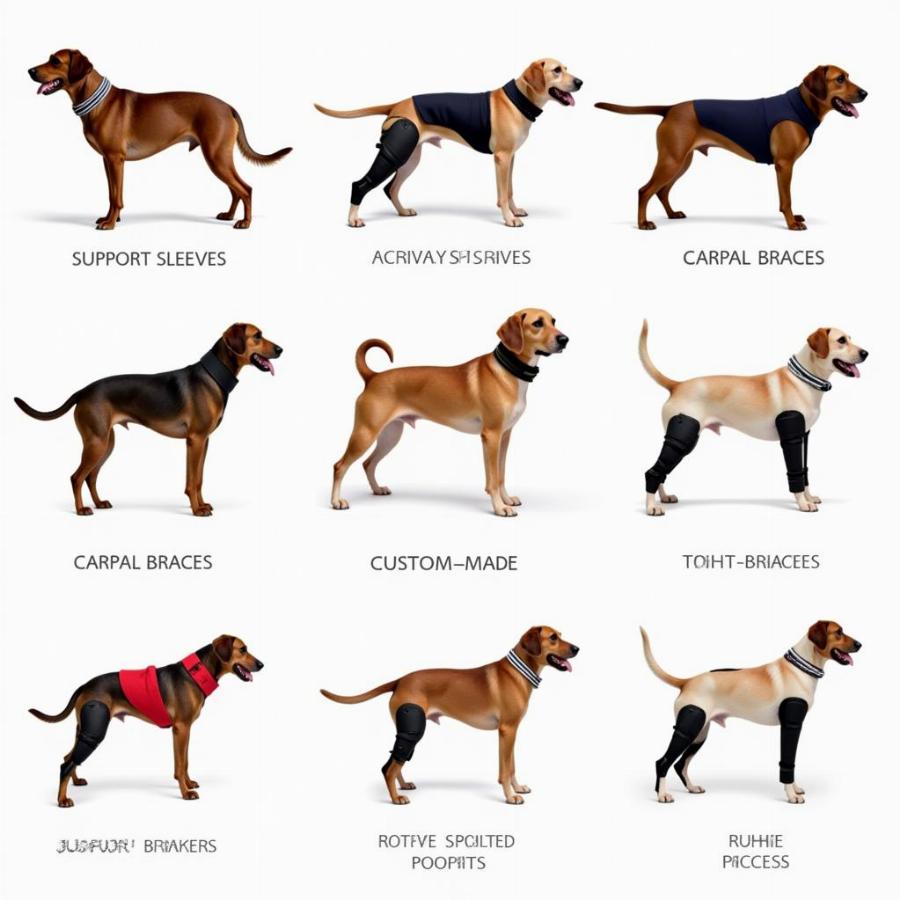A dog front leg brace can be a lifesaver – literally. Whether your furry friend is recovering from surgery, managing a chronic condition, or simply needs a little extra support, a front leg brace can provide stability, reduce pain, and improve mobility. But with so many options available, choosing the right brace and understanding its use can feel overwhelming. This comprehensive guide dives deep into the world of dog front leg braces, equipping you with the knowledge to make informed decisions for your beloved canine companion.
Why Your Dog Might Need a Front Leg Brace
 Types of Dog Front Leg Braces
Types of Dog Front Leg Braces
Front leg braces in dogs address a range of issues, from acute injuries to long-term conditions. Here are some common reasons your veterinarian might recommend a brace:
- Post-Surgical Support: After surgery, a brace can stabilize the leg, protect the surgical site, and promote healing. This is particularly important for procedures involving ligaments, tendons, or bones.
- Arthritis Management: Just like in humans, arthritis in dogs can cause pain, stiffness, and reduced mobility. A brace can provide support, alleviate pressure on joints, and improve overall comfort.
- Ligament Injuries: Cruciate ligament injuries, common in active dogs, often require surgery. A brace can be beneficial during both the recovery phase and for long-term management.
- Neurological Conditions: Certain neurological conditions can lead to weakness or instability in the front legs. A brace can offer support and help dogs maintain their balance.
- Other Conditions: Braces can be helpful for dogs with conditions like carpal laxity (weak wrists), hyper extension, and even fractures.
Types of Dog Front Leg Braces
Choosing the right brace depends on your dog’s specific needs and the severity of their condition. Here’s a breakdown of common types:
- Support Sleeves: These lightweight braces provide compression and warmth, offering mild support for minor injuries, arthritis, or general instability.
- Carpal Braces: Specifically designed to support the wrist joint, these braces are ideal for dogs with carpal laxity or those prone to hyperextension.
- Walkabout or Rear Lifting Harnesses: These aren’t strictly front leg braces but can provide support and assistance to dogs with weakness in their front or hind legs, allowing pet parents to help them stand or navigate stairs.
- Custom Braces: For more complex injuries or conditions, your vet might recommend a custom-made brace. These braces offer a precise fit and maximum support, tailored to your dog’s unique needs.
What to Look for in a Dog Front Leg Brace
Navigating the world of dog braces can feel daunting. Here are key factors to consider:
- Support and Stability: The brace should provide adequate support for your dog’s specific condition. Consult with your veterinarian to determine the level of support required.
- Comfort and Fit: A well-fitting brace should be snug but not too tight, allowing for a full range of motion without chafing or restricting blood flow.
- Durability: Choose a brace made from high-quality materials that can withstand wear and tear, especially if your dog is active.
- Ease of Use: Opt for a brace that’s easy to put on and take off, with secure fastenings that won’t come undone easily.
- Breathability: A breathable material will help prevent moisture buildup and keep your dog’s skin dry and comfortable.
Tips for Introducing and Using a Front Leg Brace
Introducing a brace to your dog requires patience and positive reinforcement. Here’s how to make the process smoother:
- Gradual Introduction: Allow your dog to sniff and investigate the brace before attempting to put it on. Reward them with treats and praise for calm behavior.
- Short Sessions: Start with short wearing sessions, gradually increasing the duration as your dog becomes more comfortable.
- Positive Association: Make wearing the brace a positive experience by pairing it with treats, praise, and short walks.
- Monitor for Discomfort: Regularly check for any signs of chafing, redness, or discomfort. Contact your veterinarian if you notice any issues.
When to See Your Veterinarian
While a dog front leg brace can be incredibly beneficial, it’s crucial to consult with your veterinarian for a proper diagnosis and treatment plan. If you notice any limping, swelling, or pain in your dog’s legs, schedule an appointment right away.
Dog Front Leg Braces: Supporting Your Best Friend’s Mobility
A dog front leg brace can significantly improve your furry friend’s quality of life, providing support, reducing pain, and promoting healing. By understanding the different types, features, and fitting considerations, you can make informed decisions to help your canine companion live their best life. Remember, a trip to the vet is always the first step in addressing any leg injuries or concerns.
FAQs About Dog Front Leg Braces
- How long will my dog need to wear a front leg brace?
The duration varies depending on the condition being treated. Your veterinarian will provide specific recommendations for your dog’s recovery plan. - Can my dog sleep with a front leg brace on?
It’s generally recommended to remove the brace at night to allow the leg to breathe and prevent skin irritation. - Will my dog’s leg become dependent on the brace?
While a brace provides support, it’s not a substitute for proper rehabilitation. With appropriate therapy, your dog’s muscles should strengthen over time. - Are dog front leg braces expensive?
The cost varies depending on the type, brand, and whether a custom brace is needed.
Looking for more helpful tips on caring for your canine companion?
- Learn about xxxl dog costume options for your larger breed.
- Find the perfect small dog rain jacket to keep your little one dry.
Beaut Dogs: Your Trusted Source for Dog Care
Beaut Dogs is your go-to resource for all things dog-related. We’re dedicated to providing pet parents with reliable, informative, and engaging content to help you provide the best possible care for your furry companions. For any questions or concerns, please reach out to our team at [email protected]. We’re always happy to help!